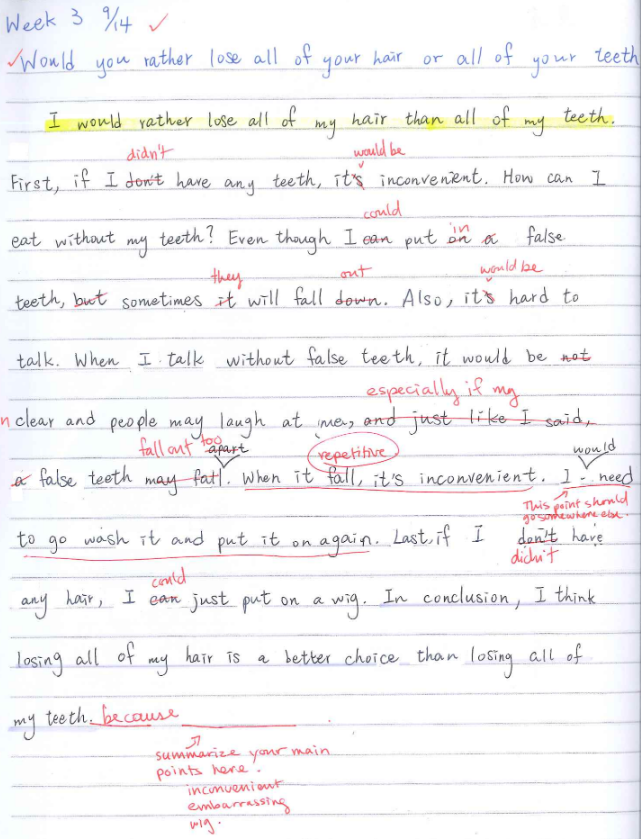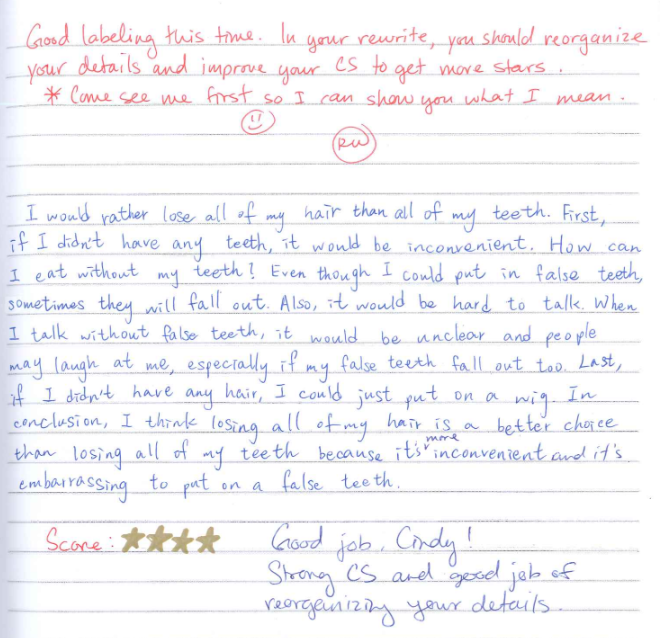“When compared to traditionally taught classes, students in mastery learning classes consistently have been shown to learn better, reach higher levels of achievement, and develop greater confidence in their ability to learn and in themselves as learners.”
– Thomas Guskey, professor of Educational Policy Studies and Evaluation at the University of Kentucky
Mastery learning is a system where students need to master specific tasks before moving on to other tasks. This is in contrast to traditional methods where teachers assign students a task and give students a grade. Then, everyone just moves on to the next task, regardless of how students performed.
Students should have more than one chance to succeed. Mastery learning lets us give students those opportunities. It works like this:
- Students attempt a writing task, and they keep attempting it until they master it.
- Students will learn that rewriting is the essence of writing.
- Students will learn how to go above and beyond to develop work that they can be proud of.
- Students can turn in work as many times as it takes to master it.
- Teachers might need to explain concepts a few times to students, both in class and individually.
- Teachers offer “correctives” or instruction tailored to each student individually on how to improve.
- Teachers will need to correct writing tasks more than once.
How we implement it at Englist
We understand that some students learn more quickly than others. Even within one class there is variation in student ability and work habits. This means that while some students may have mastered a task, other students may still be progressing.
To address this, we want students to keep trying tasks until they master them. The class might need to move on to the next task to stay on schedule. But if students are stuck on one concept, they have a few options.
First, we may encourage a student to stick with a task until they master it and to catch up at their own pace. Or, we may ask a student to move on for now, but then revisit the task later on when they have more experience.
This means that students can turn in writing tasks again and again until they have mastered the assignment. Obviously students need to turn work in on time for their first and second drafts. After that, however, there is no “late work”, especially if the teacher has asked a student to re-attempt a writing task.
The way we implement this into our semester schedule is as follows:
- Week 1: The teacher explains and then models a writing task. Students complete their first attempt, called the first draft.
- Week 2: The teacher uses student work to explain where students could improve. Students reattempt the task, sometimes from scratch, called the second draft.
- Week 3: The teacher moves on to the next writing task. If students have not mastered the work, the teacher will encourage the students to attempt it again.


Levels of Mastery
- Incomplete / missing
- The work is unfinished or the student did not turn it in.
- Insufficient – 1
- The work is finished, but it shows low effort and does not fully adhere to directions.
- Developing – 2
- Effort is apparent, but it comes up lacking, either based on the rubric, or it is insufficient in terms of structure, clarity, reasoning, or mechanics (or any combination of these).
- Proficiency – 3
- The work displays strong effort and is sufficient relative to the rubric and the elements of writing. It might, however, be derivative, unoriginal, lack creativity, or just be boring / unengaging.
- Mastery – 4
- This work is special. It is engaging to read, unique, creative, and almost flawlessly executed.
Most scores will fall in the 2-3 range, especially on first drafts or attempts. Students can re-attempt each task to attain “mastery” scores.
Each writing task will take at least two lessons – once for the lesson and the first draft, and the second week for leveling up and mastery so students have the opportunity to elevate their work.
Backwards design and curriculum development
Mastery learning is how Englist teachers are instructing students in the classroom. But for mastery learning to be effective, teachers must first develop a curriculum that students can master. The way we develop our curriculum is through a method called “backwards design” that complements mastery learning methodologies.
We start with the question: “What do we need students to learn?” From this question, we can develop objectives, or goals, that we expect students to master by the end of an academic term or unit. From these objectives we select lessons and materials that students will use to master the tasks and objectives required. This process is called instructional alignment:

Frequently asked questions
Of course parents and students have questions about mastery learning. Here are some of the most common:
What if my student is already really good at a task?
That’s great. There could be a few things going on. First, the student may be repeating something they had not mastered before and are attempting it again. Next the student may just be good at this specific task.
If a student is receiving mastery scores on first draft after first draft, then perhaps teachers and parents need to discuss moving the student to a more challenging class. However, most students will not start out as “masters” of a writing assignment, even if they do show proficiency. And if they master one assignment, that does not mean they will consistently master all assignments with ease.
What about students who struggle with tasks?
Most students will struggle with a task from time to time. And like above, if a student is consistently earning “incompletes” or a 1 on their work, perhaps the teacher and parents need to discuss moving the student to a less challenging class.
However, if students are not generally mastering each task, that is okay. At Englist we usually want students to remain at the same “level” for a year, or even two. A student might see some of the same tasks again the next time around. However, this review is useful and it gives the student the chance to succeed where they might have struggled before. So even if a student is not mastering every assignment now, that is okay – give it time.
Does using mastery learning mean students will cover fewer topics?
Yes and no. Students might not cover as many topics over the course of a term, but over the course of an academic year they will likely cover as many topics as traditional classes. This is mostly because as students get better at the mastery learning process, they spend less time needing correctives and things can speed up. It depends on the class.
But more importantly, students will dive deeper into the important topics in writing, and teachers will have time to work individually with students to address the individual issues that a student is struggling with. So, again, it depends on how you look at it.
At Englist we believe in going slow and being comprehensive
Our teachers love to say “writing is thinking”. However, we know that thinking isn’t always an instantaneous process. Sometimes it takes a while. Thinking can be hard, and thinking deeply and comprehensively is even harder.
Mastery learning offers teachers and students the space and time to mentally marinate in ideas and strategies. Doing so lets students develop better thoughts and produce strong, unique, and creative work. This process is more authentic to how life works, and students appreciate the learning process not just as something they need to rush to finish, but as something that will help them become wiser and more capable.
